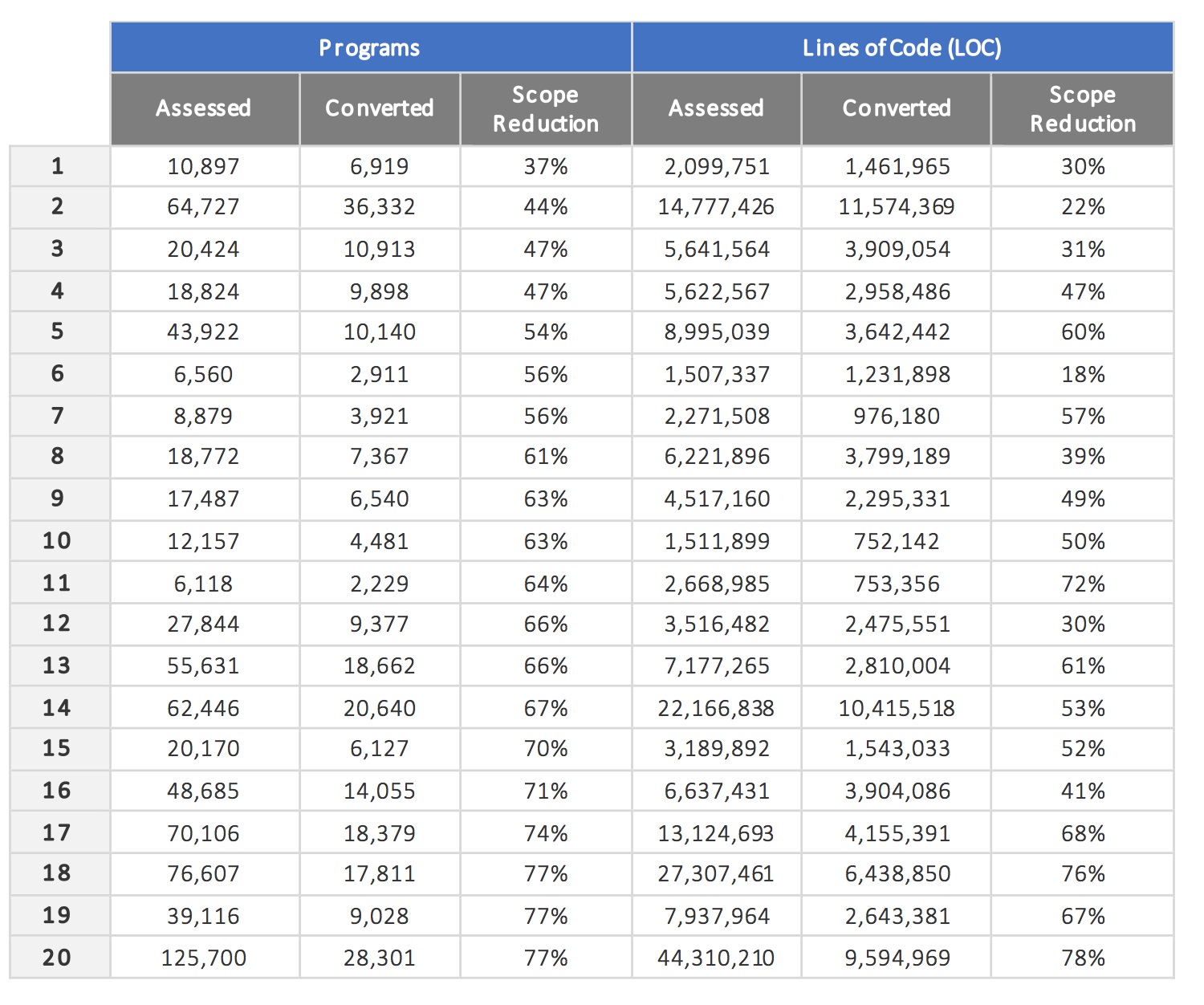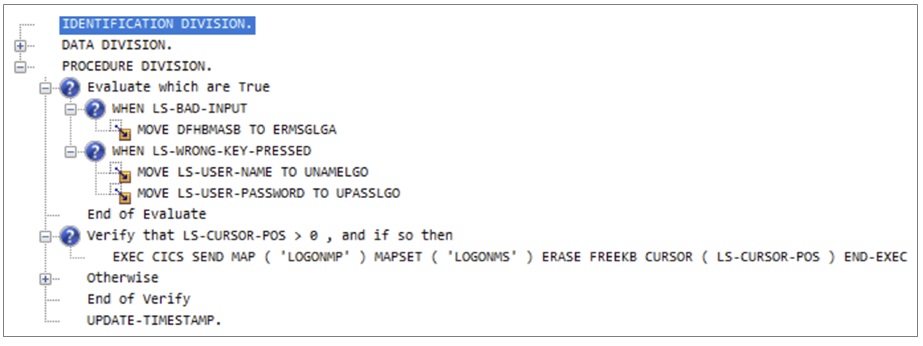AWS Partner Network (APN) Blog
Mainframe Modernization Platform-as-a-Service (ModPaaS) from Modern Systems
 |
 |
 |
By Barry Tait, Director of Modernization and Cloud Strategies at Modern Systems
Mainframe modernization has shifted to go well beyond simple cost-cutting measures. Mainframe legacy owners now expect additional gains such as conversion to maintainable object-oriented languages, shift of infrastructure to leverage elastic Amazon Web Services (AWS), and development of agile-based processes.
Demand has driven increased adoption of rules-based automated conversion of legacy languages to Java or C#, or a longer-term strategic refactor to cloud-native architectures.
Typical modernization projects see vendor-skilled resources use specialized migration tools, while customers focus primarily on testing, operations, and business subject matter expertise. Newer modernization approaches require increased customer involvement. Breaking down monolithic workloads into microservices is an extremely complex task requiring a deep level of analysis, planning, and hands-on domain expertise.
In this post, we explore Modern Systems’ Modernization Platform-as-a-Service (ModPaaS) that allows customers to collaborate in a highly-customizable manner. Modern Systems is an AWS Partner Network (APN) Select Technology Partner, and ModPaaS is available on AWS Marketplace.
Introducing ModPaaS
ModPaaS gives you access to Modern Systems-developed modernization solutions “as a service” on AWS. It can be used in a self-service manner, with assistance from Modern Systems’ modernization specialists, or in a fully-managed approach similar to traditional project engagements.
Having access to ModPaaS for assessments allows you to:
- Perform a comprehensive assessment of existing legacy applications, including asset count and asset type categorization, missing and unreferenced components, program flows, impact and code path analysis, reporting and documentation, and more.
- Categorize objects and applications to determine disposition options such as rehost, automatically convert, reengineer, and replace. Customers can then drive ongoing modernization initiatives with different levels of assistance.
- Trace and isolate COBOL-based business rules, which can be reused for reengineering initiatives.
- Develop a strategic modernization plan that includes recommendations and estimates that best suit your individual technical and business needs.
- Select and extract code to be modernized. For example, you can select code specific to the User Interface (UI) layer or data access objects to aid microservices development. I describe post-assessment options later in this post.
Using ModPaaS for an Assessment
At the heart of ModPaaS is the Modern Systems Enterprise Application Viewer (eav), an automated assessment solution that has been used to process millions of lines of legacy code.
Figure 1 represents the ModPaaS assessment process, and the numbers in green represent each step in the process and correspond to the related text under the image.
Figure 1 – Modern Systems’ ModPaaS assessment process overview.
Using ModPaaS for an assessment involves the following steps in Figure 1:
- Within your AWS account, launch a Windows-based ModPaaS instance based on the AWS Marketplace ModPaaS AMI.
- Populate the Modern Systems eav asset repository with legacy source code and data definitions.
- Automatically parse assets, produce asset counts, categorize types, perform impact analysis and code path analysis, generate program flows and dependencies, and create numerous reports and documentation. Steps 2 and 3 are an iterative process, performed until all assets reported as being missing are resolved.
- Collaboratively analyze results and further categorize assets into specific application groups based on possible disposition strategies. Discuss modernization options, associated migration tasks, service levels and pricing, and define statements of work (SOW) with Modern Systems.
Benefits of Using ModPaaS for an Assessment
Complete Visibility into the Legacy System
By using ModPaaS for a modernization assessment, you get complete visibility into the legacy system. Assets loaded into ModPaaS are automatically parsed, counted, and categorized by asset type. You can automatically generate reports and documentation as well as program interactions to represent the overall program flow, individual paragraph flow, and inter-relationships between the programs, data, and other component types.
Reduced Application Footprint
With ModPaaS, you also get a reduced application footprint. You can interactively analyze results to resolve assets being reported as missing, unused, or unreferenced. This is a critical task as it reduces the cost, complexity, and risk of the future modernization project.
The table in Figure 2 lists actual scope reduction results from 20 past projects, ranging from 40 to 70 percent.
Figure 2 – Project scope showing programs and lines of code.
Global Reports and Documentation
ModPaaS also gives you access to global reports and documentation. Each time it parses an asset, ModPaaS automatically updates its documentation repository, generating multiple reports such as Object Summary, Complexity Detail, Missing Objects, CRUD Detail.
All of these are downloadable as PDFs and exportable into a variety of formats for further manipulation. Figure 3 shows a sample report provided by a ModPaaS assessment.
Figure 3 – ModPaaS assessment object metrics.
Code Clean-Up
Additionally, ModPaaS assists with the clean-up of COBOL code to make future maintenance more efficient. It automatically identifies programs and copybooks, which are potentially not used and therefore may be deleted from the code base.
ModPaaS can also remove unreachable paragraphs and sections within the code, as well as identify and remove unreachable executable lines in the code and unused variables in the code and copybooks. Figure 4 shows a dead code analysis on a program tree subset.
Figure 4 – ModPaaS dead code analysis on a program tree subset.
Business Rules Mining
ModPaaS assists with reengineering initiatives, such as the creation of microservices functionality, by allowing you to mine mainframe COBOL business rules from within application logic. You can extract select rules from your code, save them as COBOL, and then later automatically convert them to the target language (such as Java or C#) and further optimize and refactor them as required outside of ModPaaS.
Gaining an understanding of inter- and intra-process flows is important in developing independent, single-function components suited to a microservices architecture. Figure 5 shows a business rule being mined.
Figure 5 – ModPaaS assessment business rules mining.
Application Categorization
ModPaaS bridges and processes the top-down results of a business assessment with the bottom-up results of a technical assessment, providing the ability to confirm, invalidate, or refine your target disposition options. You can create categories for a single application, multiple applications, or even an identified sub-domain following a service modelling exercise.
ModPaaS will define entry points into a category (screens, transactions, batch jobs) and dynamically generate results to show associated dependencies and interactions between objects in the category. From these results, you can determine how tightly coupled specific objects in a given category are, what the complexity values of specific objects within a category are, or what the interaction points between multiple categories are.
Post-Assessment Modernization Options
Modern Systems supports multiple modernization options post-assessment, which map to the different disposition options and categories identified, including:
- Rehosting COBOL and Natural-based applications to Amazon Elastic Compute Cloud (Amazon EC2) instances.
- Automatically converting COBOL and Natural-based applications to Java or C# running in Amazon EC2 instances, and modernizing legacy data stores to Amazon Relational Database Service (Amazon RDS). You can apply different levels of application refactoring and optimization to achieve the desired level of elasticity and availability.
- Re-engineering selected business functions or application groups to support a cloud-native architecture such as microservices. You can drive this option from ModPaaS with different levels of support from Modern Systems.
- Determining specific functionality to be retired or replaced with a packaged application. Similar to re-engineering options, you can drive this from ModPaaS with different levels of support from Modern Systems.
You can obtain estimates from Modern Systems for each different modernization option and the related service tasks. Then, you can decide on the required level of engagement for both parties.
Adding Automated Conversion
The image in Figure 6 represents the end-to end-modernization approach with ModPaaS when selecting an automatic conversion of COBOL to Java or C#.
Figure 6 – Modern Systems end-to-end modernization process overview.
The steps above are specific to using ModPaaS during an assessment and described previously, while the steps below relate to post-assessment modernization activities where identified COBOL source code is extracted, analyzed further to determine fixed-bid conversion pricing, and automatically converted to Java or C#.
Steps in Figure 6 for conversion of identified COBOL source code or business rules to Java or C#:
- Identify select assets to be analyzed and converted and export them from ModPaaS into a Modern Systems GitLab SCM repository.
- Extract assets from GitLab into a ModPaaS conversion system running in a Modern Systems AWS account. Analyze code to determine conversion effort and delivery options with fixed-bid pricing. When ready to proceed, execute the code conversion process, returning code to a level of completeness based on the selected delivery option, ranging from clean compile through to conversion with functional equivalence. A future roadmap item is to support a completely automated and dynamic conversion delivering code with default customization options and no services or support.
- Export and populate the converted code into a target GitLab SCM repository, ready for continued modernization.
- Optionally create a continuous integration workflow for the converted code, either on a separate Amazon EC2 instance, or on an existing ModPaaS instance.
- Manage converted code in preferred development environment and continue modernization efforts.
Next Steps
The ModPaaS differentiation is its ability to enable participation in modernization projects in a manner not previously available. It provides full control over the discovery, assessment, planning, and ongoing modernization process at your own pace and resource availability level, and with as much or as little assistance from Modern Systems as needed.
You can launch ModPaaS for assessments within your AWS account in the AWS Marketplace >>
The content and opinions in this blog are those of the third party author and AWS is not responsible for the content or accuracy of this post.
.
 |
Modern Systems – APN Partner Spotlight
Modern Systems is an APN Select Technology Partner. They are a legacy modernization company with proven expertise across all areas of legacy code and data migration, infrastructure, operations, monitoring, and maintenance—both during and after the transition.
Contact Modern Systems | Solution Overview | Buy on Marketplace
*Already worked with Modern Systems? Rate this Partner
*To review an APN Partner, you must be an AWS customer that has worked with them directly on a project.





